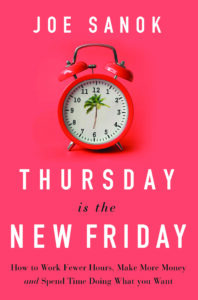A New Way to Work
Will the four-day workweek become the norm within our generation? With growing statistics around the Great Resignation, employees aren’t returning to work in the way expected post-covid-19. In his book Thursday is the New Friday: How to Work Fewer Hours, Make More Money, and Spend Time Doing What You Want, Joe Sanok outlines how we arrived at this point in history, what we each can do internally to thrive, and how slowing down is actually the key to growing productivity and creativity.
Talk about your findings on productivity and the 40-hour workweek. And how did the five-day workweek start in the first place?
In order to fully understand where we are now, we need to go back several thousand years to the Babylonians. The Babylonians had a unique way of thinking about the universe, all that they saw in the sky that mattered to them was the sun, earth, moon, Mercury, Venus, Mars, and Jupiter. So they started the seven-day work week. The Egyptians had an eight-day week, and the Romans had a ten-day week. In fact the Romans didn’t even switch over to the seven-day week until one of their Emperors converted to Christianity in the 300s.
We start with the fact that time is made up and what we think is normal we actually created. Fast forward to the late 1800s and early 1900s, the average person was working 10 – 14 hours a day six or seven days a week. Then in 1926, Henry Ford started the 40-hour workweek in order to sell more cars to his employees. He thought that people would not buy a car to get to work faster, but instead they would if they had a weekend to go recreate. So even the 40-hour work week, which feels like part of our institution, was completely made up less than a hundred years ago.
That brings us to today. We know intuitively that our best work does not come when we are stressed out or maxed out. Instead it is when we slow down. We have our best ideas in the shower, when we are out for a hike, or when we are driving and have the radio off. Research continues to show that our best and most creative ideas come when we slow down and optimize the brain, instead of working the typical work week. Health outcomes, productivity outcomes, and the ability to think outside the box are all worse when we are stressed out and overworking.
Given this history, and the need to evolve to a new future, how do employers best make the transition to a less than 40-hour workweek?
What we are seeing is that effective transitions happen in small teams of people. Typically it will be a group of six to eight people that have all read the book together and want to implement it. The first step is to gather those like-minded people to create a plan. Usually you want to involve a supervisor and make sure that the people in the group all have similar types of roles within the company. Bringing it to the supervisor correctly is important. Usually saying something like, “We want to do an experiment to work 4 days a week over a period of two or three months. We want to give you specific updates and look at the key performance indicators so that when we create innovation, you can be seen as the leader of this.”
The next step is to create the key performance indicators for the team. What are the two or three things the indicate how the team is already judged? How will this be tracked? How will we know if we are successful or not?
Next, the team needs the set very clear boundaries of the time outside of work. This model is based on the idea that slowing down actually speeds up creativity, innovation, and productivity. So will the team check emails after work? Will they be expected to check emails and do work on the weekend? What as a team can they decide on to create a specific culture around slowing down? For example some teams may need to have someone on call 24/7. Setting up a schedule will be essential for that team. It only takes one person to start an email chain outside of the established boundaries to make everyone else feel like they are dropping the ball also.
Next, the team will check in every Monday morning or whichever day of the week is their first day to talk specifically around how well those boundaries were held over the previous week. This allows a strong culture to be created around time away from work as well as within work.
The team will give weekly updates to the supervisor around the key performance indicators saying which areas are up or down—as well as what action items will be taken to continue a positive trajectory or to address a -1. This shows the supervisor that the team is proactive around the specific indicators.
Lastly, at the end of each month the team will do a 360 review of what has worked, what was learned, and what needs to be changed for the future months. This is again done at the end of the experiment. Then the team with the supervisor discusses whether or not to do another experiment.
Often what happens is the team members realize that if they can do the entire week of work in 4 days and show that the experiment is a success, they will work harder to make it happen.
This model is completely based on doing experiments, rather than having a prescription that everyone follows. We talked through principles, applications, and how to learn and adapt for your particular industry. Most self-help books focus on giving a prescription whereas this one is a menu to help companies and leaders learn, decide, and adapt to this non-industrialist way of running a company. It focuses on being evolutionary and growing with the employees and the particular market the business serves.
It seems that, even if we had a 2-day workweek, work never lets up. How do we use technology to help us and not chain us to work?
That is absolutely true. Part of what this book challenges is the idea that we do have to do it all. I would argue that having very clear bookends as to when we can say, “Enough is enough,” actually leads us to work on the best and often most profitable work, instead of just checking things off of our to-do list.
When we start by looking internally and examining our motivations, then move into optimizing our brains to slow down, and then lastly do the work, it gives clarity as to what we should be doing, but more importantly what we should not be doing.
Most entrepreneurs have an ongoing list of things in their head that they should be working on. Rather than do that, one should be setting up clear personal systems as to how you capture ideas, pause them until the appropriate time, and then implement them outside of your free time is a skill set that allows entrepreneurs and business leaders to do their very best work while also slowing down.
Also, when we give ourselves less time, the tasks that are least important are the ones that we drop. That gives us an opportunity to decide if we want to continue doing those tasks, if we want to outsource those tasks, or to automate those tasks. This is where technology can be hyper effective in automating systems of actions that a leader used to do.
The personal decisions as to how available we are, how we use technology to grow our business and communication, and how much we retreat from the work is up to us. For too long we have focused on overvaluing work and undervaluing time outside of work, despite continued research showing that our best work and most creative work comes when we slow down.
Covid-19 also is a wakeup call for many to question our lives and reset our future. How are you seeing work from home in the light of your book?
The pandemic that started in 2020 was a global experiment on how we work. In a sense it was the final nail in the coffin for the industrial list age. In retrospect, we were moving away from stinking like industrialists a long time ago. We no longer think of people as just part of the machine, we don’t treat people like they’re just part of an assembly line. We understand the world is more nuanced than that. The pandemic allowed us to ask an important question “Why do we work this way?”
Many decided not to go back to a job because the employer wanted to just go back to the way it was, thinking like an industrialist and basing job performance on hours sitting in a chair. Innovative companies started to take more of an evolutionary model to see how they could adapt and change to worker needs, styles, and innovations.
Working from home is just one of many new modalities we will continue to see in the coming decade. There will be hybrid models, digital nomad models, and models that we have yet to predict because the technology has yet to be created. Businesses of the future will no longer take the industrialist model and instead will adapt, change, and evolve with workers and within industries.
I love the story of your own lemonade stand and then your daughter taking on the challenge. What lessons did this teach you?
 In the book, I talked about how my daughter and I looked at a lemonade stand that she wanted to start. Instead of doing the typical lemonade that you sell for $0.25, she decided to do hand squeezed lemonade with the option of fresh cut basil and frozen strawberries. She also sold coffee because her lemonade stand was in the morning during a marathon. Rather than the typical child sitting around and getting charity quarter cups of lemonade she had a line 10 people deep end made around $100 per hour.
In the book, I talked about how my daughter and I looked at a lemonade stand that she wanted to start. Instead of doing the typical lemonade that you sell for $0.25, she decided to do hand squeezed lemonade with the option of fresh cut basil and frozen strawberries. She also sold coffee because her lemonade stand was in the morning during a marathon. Rather than the typical child sitting around and getting charity quarter cups of lemonade she had a line 10 people deep end made around $100 per hour.
For me, this just reiterated how much people want quality in their life. We are past the information age. We are in the implementation age. We want shortcuts. Effective leaders, entrepreneurs, podcasters, and consultants are the ones that show how to implement something quickly whether that is some new technology or a delicious glass of lemonade.
You share research about slowing down and how it actually increases productivity and creativity. That contrasts to the feeling that many of us have where it is difficult to slow down, turn it all off, and recharge. Share your perspective on the research and the best ways to make it happen.
Even though we find it difficult to slow down as high achievers, when we do, it unlocks new and innovative ideas. If we really step back and think about our work on a Friday or maybe working and emailing at 9 or 10 at night after the kids are in bed, is that quality of work the same quality as when we are hyper-focused at 10 a.m. on a Monday morning? What if instead of trying to fit everything in, we started with the question of “When am I at my best to get the best quality of work done?”
One simple task that someone can do is to evaluate their weekend. What is one thing that you can add to your weekend they will add a sense of adventure, health, or personality? Also, what is something that you can remove from your weekend to reduce stress, increase the amount of time you have doing what you want, or help you rest more? Sometimes adding in an additional hike on a weekend and outsourcing getting groceries can help us feel more rejuvenated starting the next week.
As well, when we look at the research on happiness, health outcomes, and productivity, we can see that the typical #hustleculture is not working. We are more unhappy, we are sicker, and we are not as productive as we think we are. Over and over, research studies show that when we can align our physical and mental bodies to what we do in the work world we get better work done in a shorter period of time.
How do we best eliminate tasks that are non-productive in order to free up our time for its highest and best use?
Really it depends on the particular work culture and environment. An entrepreneur can just stop doing it, outsource it to someone else, or automate through a system. It naturally happens when you give yourself less time to work on something. For example, if I know that I have 20 tasks to do in a week, but I only give myself time to do 15, will I do the best 15 or the worst 15? We will naturally work on the best 15. So for those bottom five, I need to ask myself, “Should I even be doing these tasks?”
If you are in a typical work environment, it can be helpful to frame out to your supervisor the tasks that you think you should eliminate and how that will save time and waste within the institution. Now not every supervisor has moved past the industrialist way of thinking, so when you run up against someone that doesn’t seem to understand it, it may force you to make decisions as to whether or not to stay with that particular company. This is a natural part of the process to continue to work on doing your highest and best work based on your skill set.
What are some ways to increase our curiosity? Why is this so important to the future of work?
Within the book, I talked about these three internal inclinations. These are three inclinations that top performers have. Curiosity is one of those inclinations. That doesn’t mean that if you don’t have natural curiosity, you won’t be effective, it just means that it is something that you need to work on. As kids we constantly are asking the question, “Why?”
At some point we stop doing this as adults. But moving away from just wanting a Eureka moment and saying, “That’s interesting, why did that happen?” is a great first step. Often we think that curiosity and innovation have to be something brand new. With so many products we’re bringing together current technologies in an innovative way. In a lot of ways some of the best innovation is uniquely merging two or three current technologies or products into something new. Curiosity is essential to finding pain points, seeking solutions, end understanding problems differently than the competition. The menial tasks of the future will be able to be automated and the curiosity end ideas to reshape society will be the business of the future
For more information, see Thursday is the New Friday: How to Work Fewer Hours, Make More Money, and Spend Time Doing What You Want.

